Developing a pre-owned clothing marketplace might prove a challenging task. There are many active cogs in this mechanism and you will need to take care of a lot. However, in this piece, we’ll divide everything into sizeable and manageable aspects.
Let’s see what are the most fundamental features and aspects you need to consider when starting your own marketplace.
Understanding the fashion resale market
The first thing you should do before creating any form of marketplace is to study the market you're entering. Here's everything you need to know.
Market overview
Valued at $230 billion in 2024, the secondhand clothing market has seen accelerated expansion in recent years to rank among the most dynamic part of the worldwide fashion sector. This rapid expansion is fueled by shifting consumer priorities, including a heightened focus on sustainability and cost-effectiveness.
Target audience
There are several customer types that are prevalent in this type of marketplace.
- Environmentally conscious shoppers. These buyers prioritize sustainability and reducing waste. They appreciate the chance to extend the lifetime of clothing, thereby contributing to the circular economy.
- Budget-savvy fashion enthusiasts. Resale appeals to them since they are looking for reasonably priced access to high-quality, branded, or distinctive items.
- Gen Z and millennials. Younger generations are drawn to a combination of style, affordability, and ideals like sustainability and individualism, so resale fits their lifestyle preferences.
Benefits of fashion resale marketplaces
This type of marketplace yields substantial benefits for both parties, namely buyers and sellers.
For example, here are the advantages buyers get on this platform:
- Access to stylish, high-quality fashion at a fraction of retail prices, making luxury and branded items more affordable.
- Opportunity to discover unique or vintage pieces that are not easily available in mainstream stores.
- Encourages sustainable buying behaviors by recycling clothing and decreasing the need for new manufacture.
On the other hand, for sellers, the benefits are as follows:
- A chance to declutter wardrobes while monetizing items that would otherwise go unused.
- An additional income stream appealing to those looking for financial flexibility.
- A sustainable living by reducing textile waste and extending the life of garments.
Apart from buyers and sellers, the fashion ecosystem also benefits from such marketplaces’ existence. For instance, your fashion resale marketplace:
- Encourages participation in the circular economy, where items are reused rather than discarded.
- Helps to mitigate the environmental impact of fast fashion, including excessive waste, water consumption, and carbon emissions.
- Fosters a culture of conscious consumption, raising awareness about sustainable choices.
Top players in fashion resale market
This market is not particularly dense, but you still need to study your competitors before entering. Let’s take a look at each.
ThredUp
It is one of the largest online consignment and thrift stores globally, based in the United States.
Unique features: Offers a “Clean Out Kit,” making it easy for sellers to send in clothes for resale.
Key strength: Focuses on sustainability and promotes a circular fashion economy through convenient services.
The RealReal
It is a premier luxury resale marketplace that specializes in authenticated second-hand apparel market designer items.
Unique features: Provides advanced authentication services and high-end concierge options for vendors.
Key strength: A well-established reputation for high-quality luxury fashion and accessories.
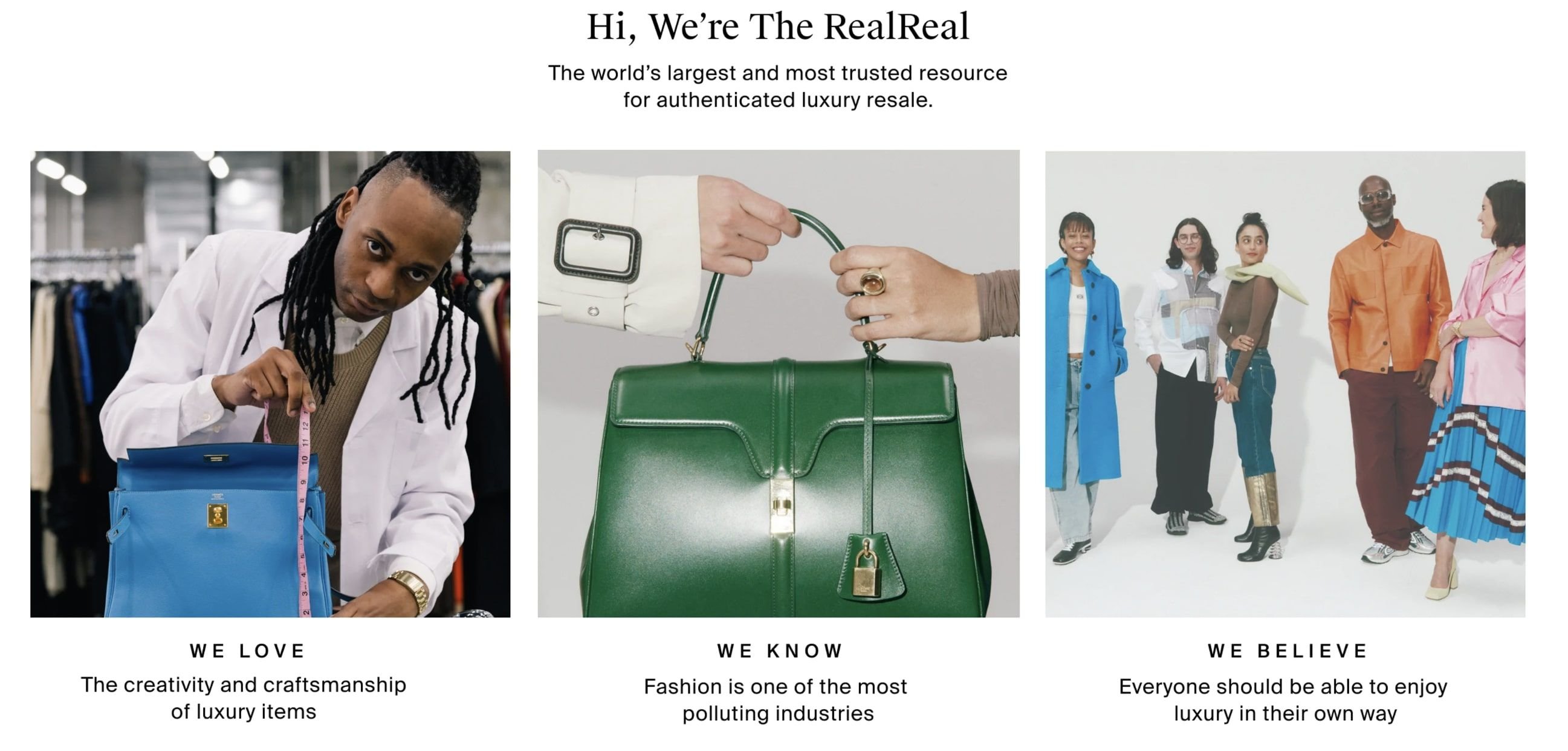
Source: The RealReal
Vestiaire Collective
This marketplace is a leading global platform for pre-owned luxury fashion.
Unique features: Provides authentication services and promotes sustainable shopping.
Key strength: Appeals to luxury buyers looking for quality and authenticity in second-hand items.
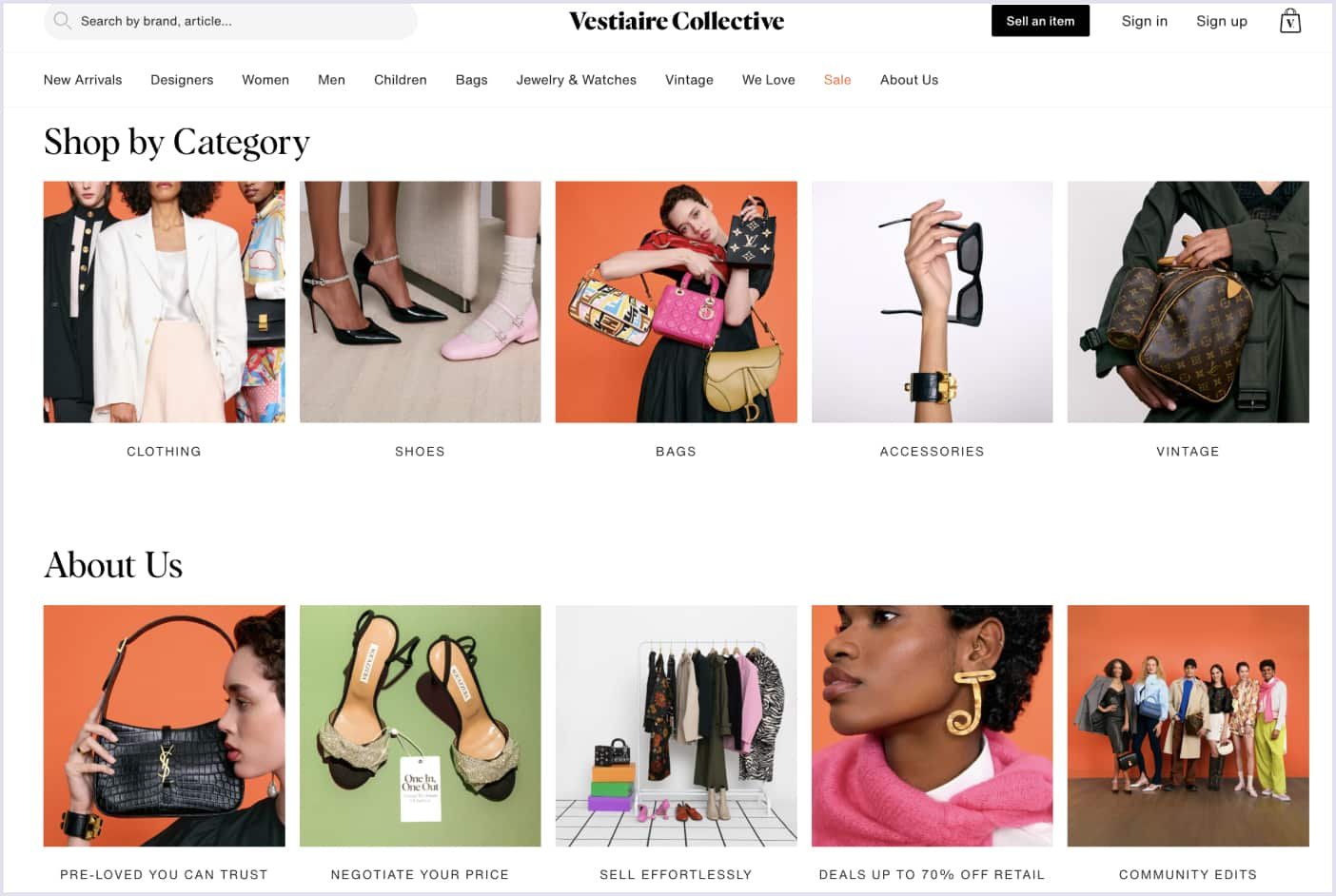
Source: Vestiaire Collective
Poshmark
A peer-to-peer platform known for its ease of use and social selling features.
Unique features: Community-driven, with sharing and liking functionalities to boost engagement.
Key strength: Reinforces strong user interactions and appeals to a wide range of demographics.
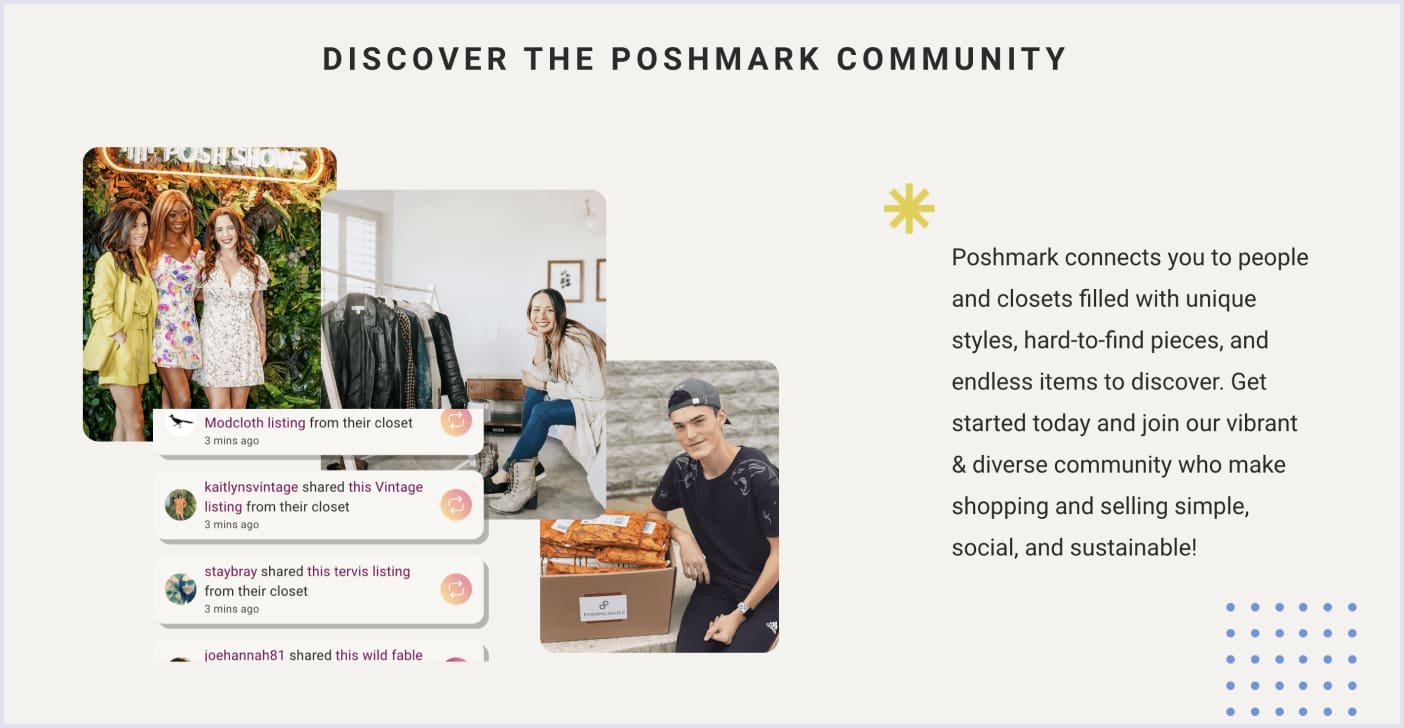
Source: Poshmark
Depop
It is a mobile-first platform targeting younger, style-conscious audiences.
Unique features: Social media-inspired interface with personalized feeds and seller profiles.
Key strength: Popular among Gen Z for its focus on vintage and unique fashion pieces.
Key features of a successful fashion resale marketplace
User-friendly interface
A good fashion resale marketplace mostly depends on a flawless and easy interface. Buyers and sellers demand easy navigation of a platform with well-defined categories, simple listings, and an aesthetically pleasant design.
An easy, readable at glance layout lowers friction, promotes longer browsing time, and raises the possibility of purchases. Here’s an example of a user-friendly interface developed by our team.
Advanced search and filter options
Efficient search and its filtering capabilities are another crucial feature you should implement. A well-designed search helps users find exactly what they’re looking for quickly and efficiently. It can be implemented in various ways.
One of the brightest examples is Algolia or Elasticsearch. With their power, you can introduce AI-powered search to your platform. They, in turn, optimize search queries, analyze patterns, and let users filter results by numerous variables.
In the aftermath, they streamline the shopping experience, ensuring users aren’t overwhelmed by irrelevant listings.
Read also: Improving Marketplace Search Using Algolia or Elasticsearch
High-quality product photos
In any marketplace, professional-looking product photos are important. When it comes to fashion, though, images are practically indispensable. Your platform should motivate sellers to post clear, high-quality photos highlighting the item from several angles.
To reinforce this requirement, your marketplace can provide photo guidelines or even in-app editing tools to enhance image quality.
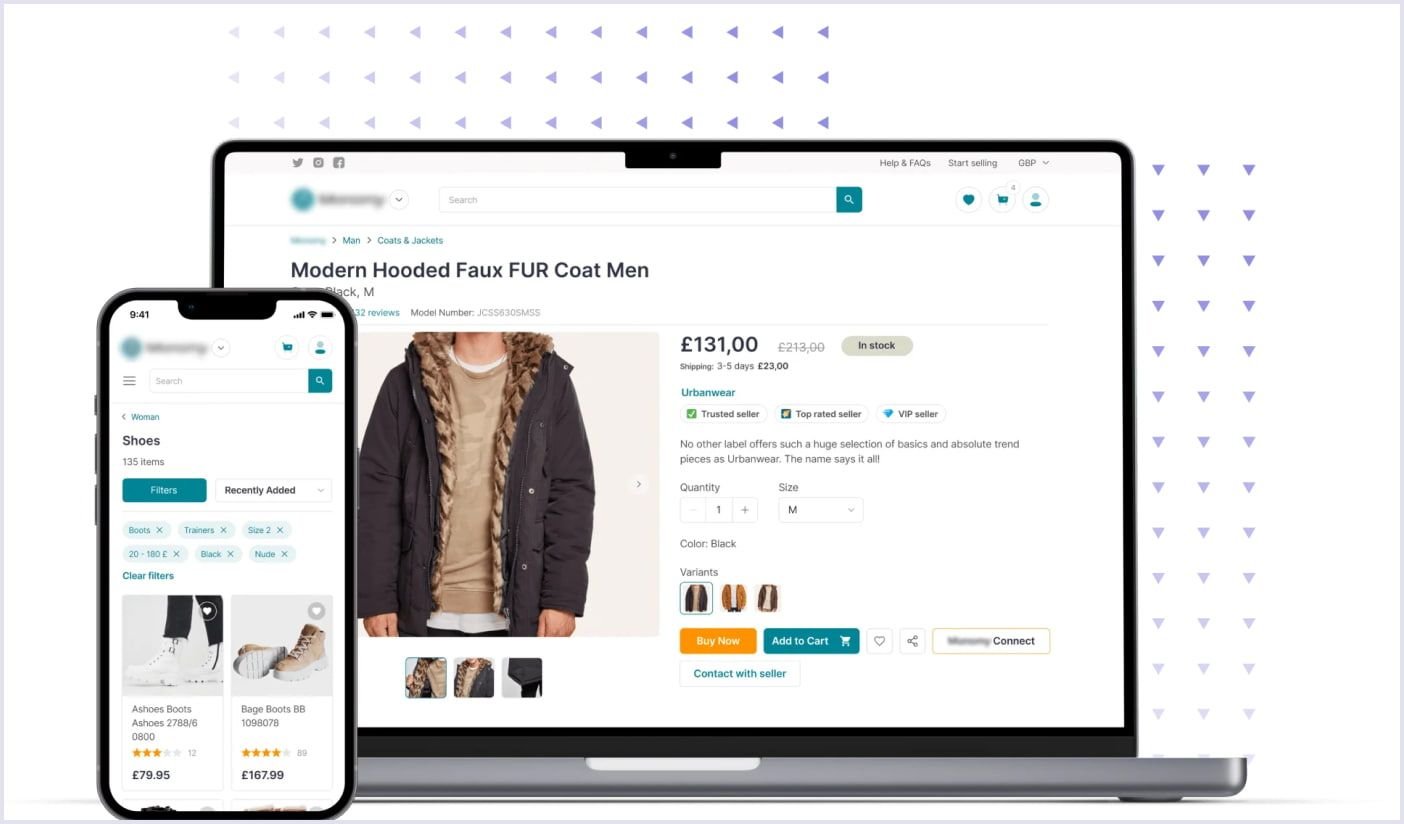
Buyer protection
Trust is the first thing you must build between the marketplace and its users. With buyer protection programs, you can secure transactions within the platform and minimize disputes.
Additionally, clear policies on returns, refunds, and counterfeit goods should be clearly visible on your page. The more users understand them, the more confidence you can build among them.
Secure payment system
One non-negotiable feature of your clothes resale market is a dependable and safe payment channel. Among many encrypted payment systems, you can implement credit cards, digital wallets, and buy-now-pay-later options.
Trust and safety measures
To increase the trustworthiness of your platform, create a safe community surrounding your marketplace. There’s a plethora of methods to do so.
For example, you can begin with user verification to reduce and eliminate fraudulent behavior. Furthermore, seller evaluations and dispute resolution procedures might contribute to increased participant trust.
Seller tools
To improve overall experience and boost engagement, give sellers tools to manage their workflow. These can be inventory management add-ons, track sales, and communication features. Besides, features like automated pricing suggestions and sales analytics can help sellers optimize their listings.
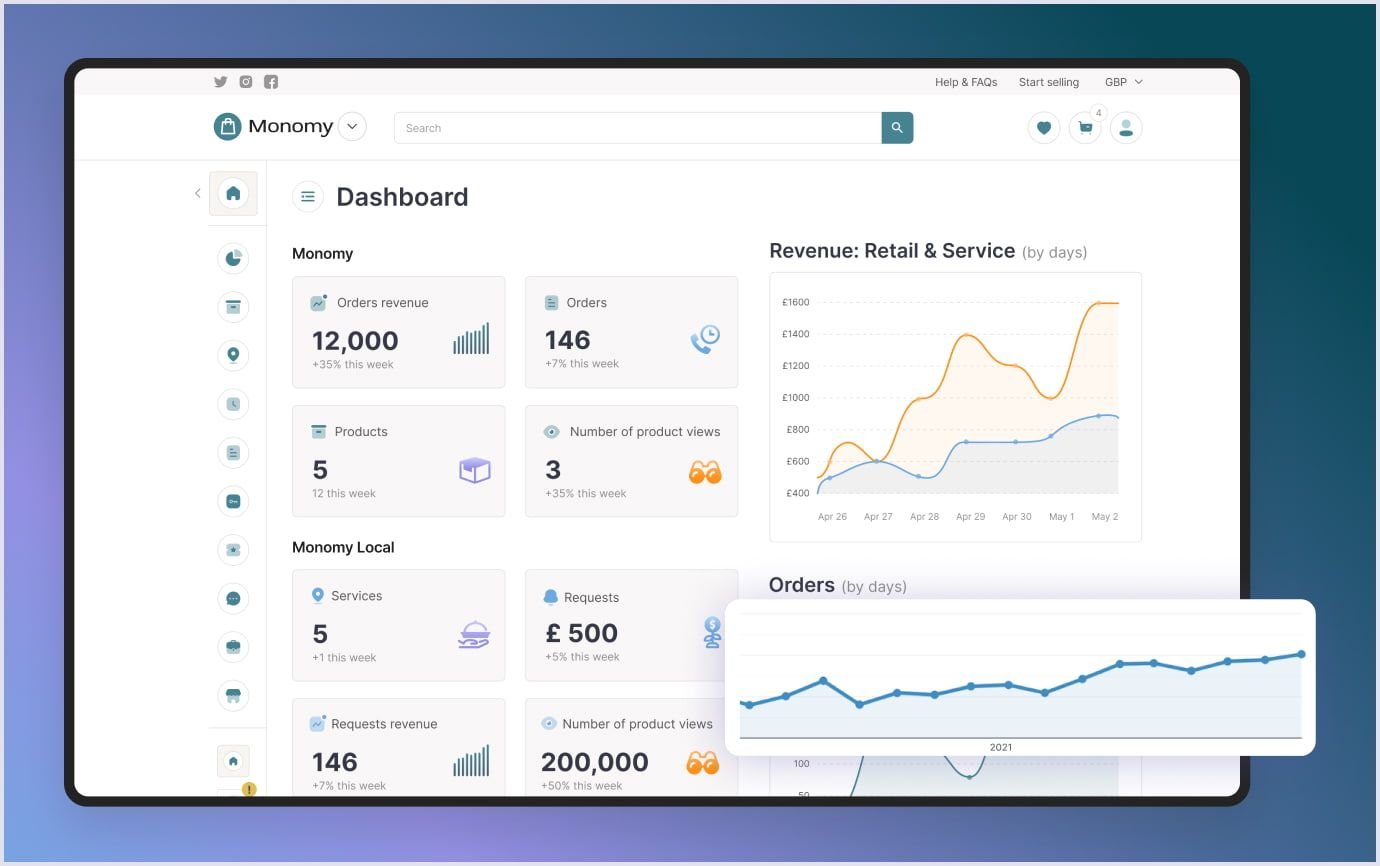
Mobile responsiveness
Apart from making a solid marketplace with a bunch of features, you have to account for all types of users who may want to use your platform. These, for instance, include not only desktop users.
On the contrary, the absolute majority of web traffic is done from smartphones. Consequently, these are the users to whom you need to give as much attention as possible.
Thus, design a mobile version of your marketplace and make sure it is as flawless as the desktop one. Perhaps you can even start with the mobile version, as mobile-first design is a popular practice in today’s software development landscape.
Sustainable practices
Promoting sustainable fashion ecommerce and eco-friendly initiatives adds value and appeals to environmentally conscious consumers. Partnering with charities, offering carbon offset programs, or educating users on sustainability can set your eco-friendly fashion platform apart.
Customer support
Quick problem resolution requires responsive customer service. Offering live chat, FAQs, and dedicated support teams ensures that consumers feel appreciated and get their questions handled quickly, which fosters loyalty and repeat usage.
Steps to develop a fashion resale marketplace
When it comes to development, Codica has got you covered. Although the marketplace development process is vast, we have a time-tested approach. According to it, we divide the entire process into manageable steps. Let’s see what they are.
Discovery phase
The discovery phase is essentially about understanding the fashion resale market covered earlier. But this time, we are not only studying it but also looking for openings to fill it with your marketplace idea.
- Market research. We analyze the pre-owned fashion market to understand customer demands, key competitors, and popular trends. These factors greatly influence the development and help us focus on aspects that drive the most engagement.
- Defining project scope. Based on market insights, we determine the core functionalities of your platform and set priorities for features to include in the MVP marketplace development.
- Setting objectives. Once everything is clear-cut, we create objective benchmarks. They often include expected user growth, income projections, or seller involvement rates.
- Prototyping. Low-fidelity prototypes are simple, rough drafts that outline your platform’s structure and user flow, using tools like sketches or basic wireframes. These quick, cost-effective drafts help focus on functionality, ensuring the core user experience is intuitive and efficient.
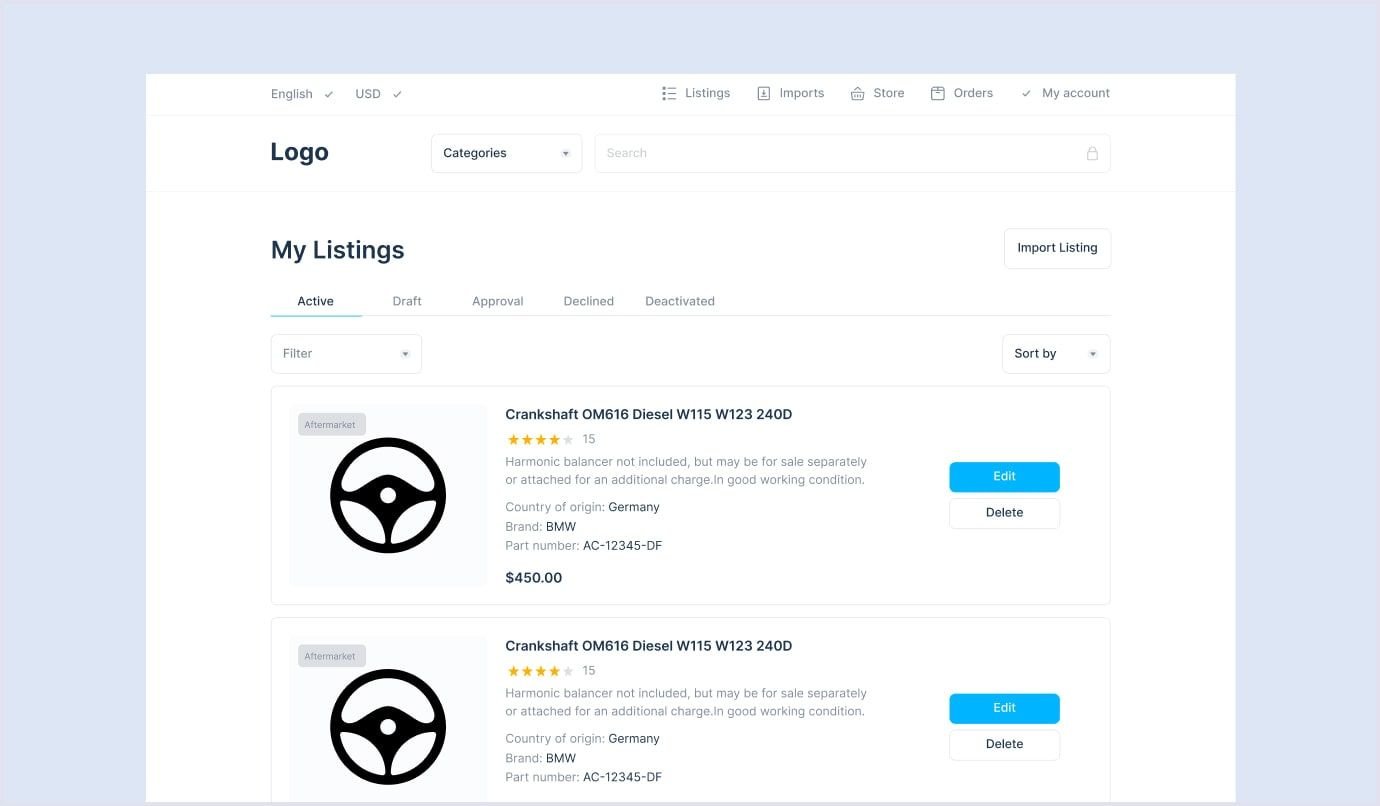
UI/UX design
Once prototypes and wireframes are completed in the discovery phase, the UI/UX design stage focuses on adding depth, detail, and polish to the platform. This step involves transforming structural plans into a fully realized, visually appealing, and user-friendly marketplace design.
So, what are the steps?
First, we work on visual design.
- Add colors, typography, imagery, and branding elements to the wireframes created earlier.
- We make sure all elements are consistent with your brand identity and reflect your marketplace’s tone.
- Focus on the visual hierarchy to guide users’ attention to key areas like search bars, featured products, or call-to-action buttons.
Second, we design responsive layouts.
- Optimize the platform for different devices, ensuring it looks and functions well on desktops, tablets, and smartphones.
- Adjust layouts and navigation elements to maintain usability across all screen sizes.
Third, we finalize user flow improvements.
- Refine workflows identified in prototypes, such as the checkout process, product browsing, or seller onboarding.
- Eliminate any friction points that could hinder user satisfaction.
Lastly, we create a design system.
- We create a design system or style guide to make sure all user interface parts (like buttons, icons, and forms) look and work the same way. This greatly helps technical specialists during the creation stage. A strong design system ensures that everything looks the same across the platform and makes future changes easier.
Choosing the right software architecture
Creating a scalable, versatile, and future-proof fashion resale marketplace depends on choosing the appropriate software architecture. Although simple and appropriate for small-scale projects, classic monolithic design has many drawbacks that make the MACH architecture the better option for contemporary platforms.
So, why is MACH architecture the best choice? For its benefits, of course.
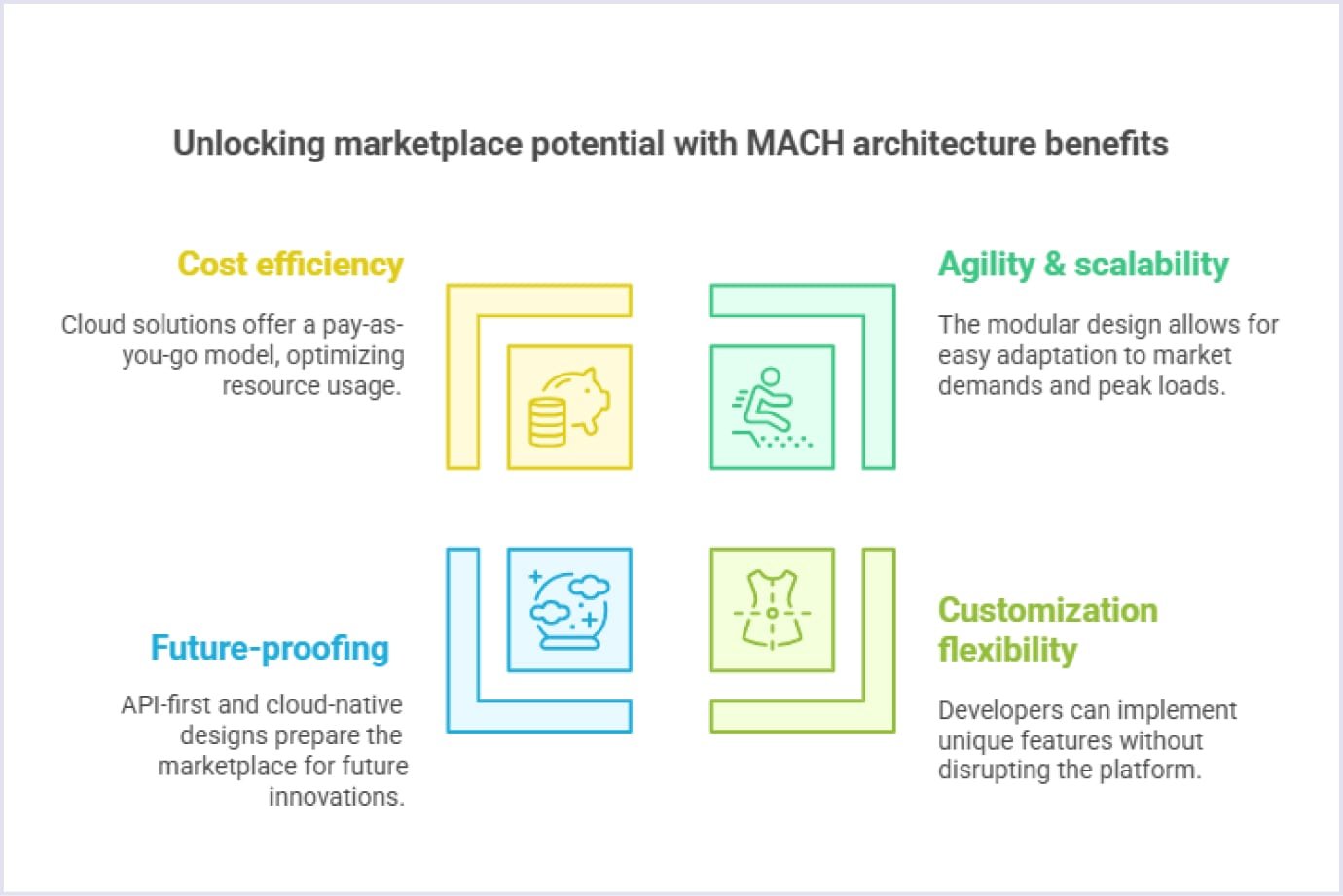
Infinite scalability. MACH design lets every service—search, payments, user authentication—scale on its own. This guarantees that your platform can manage rising traffic and transactions without straining the whole system.
Novel adaptability. MACH allows the integrating of new technologies, features, or outside tools seamlessly using APIs at their heart. You could quickly add additional search tools, link payment methods, or apply AI-powered suggestions without interfering with current offerings, for instance.
Modularity. MACH's flexible design allows you to easily adjust to market changes and use new technologies. You can update or change each part separately to keep your platform current and competitive.
Cloud-native efficiency. Built to leverage the power of cloud computing, MACH offers cost-effective scalability and superior performance. You can dynamically allocate resources based on demand, reducing costs during low-traffic periods.
Read also: Securing Marketplaces with MACH: Best Practices and Strategies
Technology stack selection
At Codica, we have a great range of technologies at hand. Thus, decisions on tech stack for online marketplace development services should match current project objectives while offering flexibility for future expansion.
- Frontend. We use tools like React or Next.js to build a user-friendly and interactive design. These frameworks are great at managing complicated activities and provide a smooth experience on different devices.
- Backend. We opt for scalable and efficient backend solutions like Node.js, Strapi, or Ruby on Rails. These provide the foundation for handling server-side logic, API integration, and database management.
- Databases. We tend to choose relational databases like PostgreSQL or MySQL for structured data or MongoDB for flexible, document-oriented storage. Scalable databases ensure smooth performance as your platform grows.
- Cloud hosting and infrastructure. With platforms like AWS, Google Cloud, or Microsoft Azure, we can provide reliable hosting, auto-scaling, and security features. They are ideal for dynamic traffic management and future scalability.
- Payment gateways. Our development team integrates secure payment solutions like Stripe, PayPal, or Square to handle transactions seamlessly and securely.
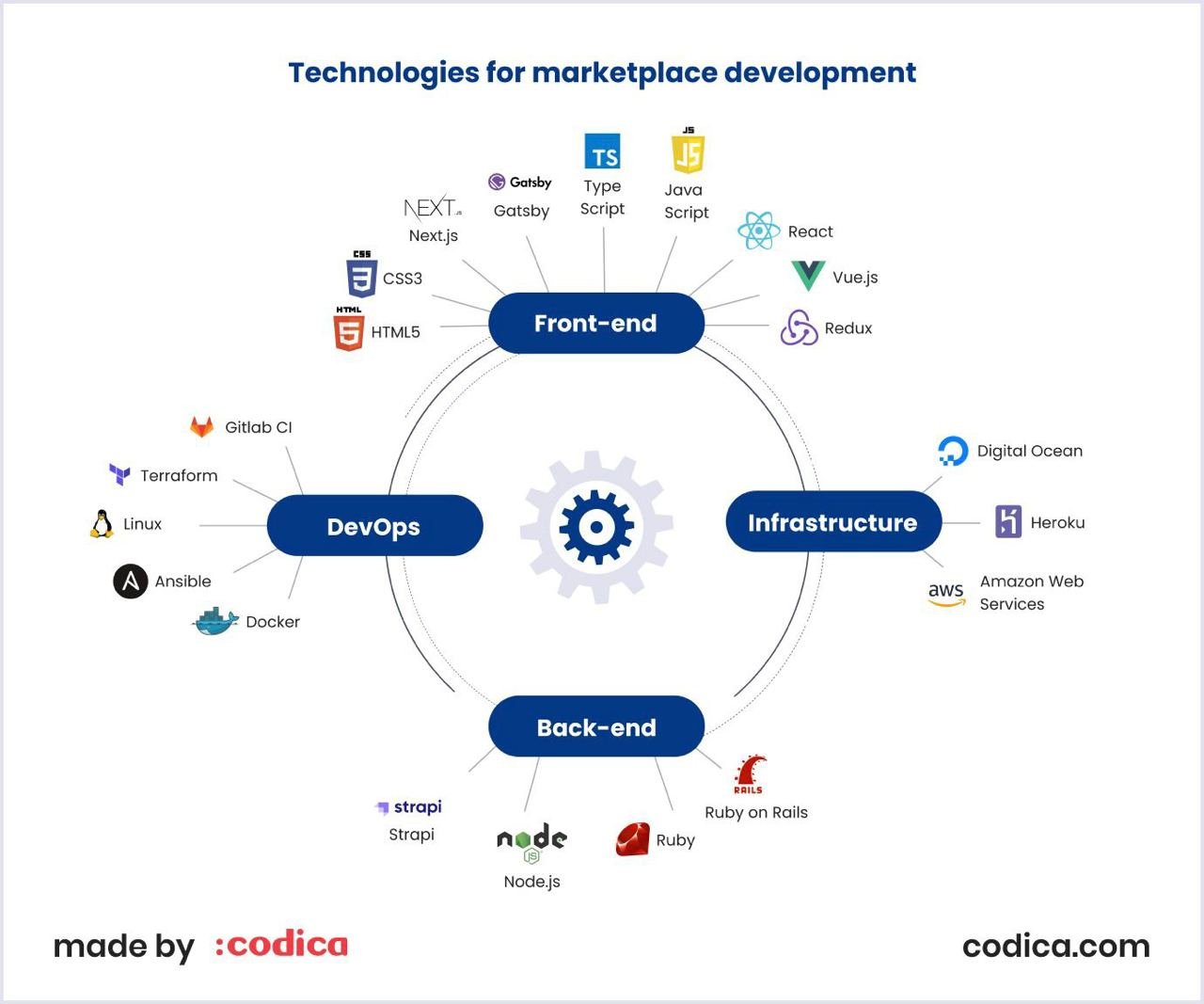
Development process
Before the full-scale development, MVP mentioned earlier would be a perfect start. During product discovery and design sessions, you would already figure out everything that should be in your MVP.
Hence, your fashion resale marketplace MVP should focus on essential features to meet user needs, allowing you to test your concept, gather feedback, and refine your product without heavy upfront investment.
When it comes to MVP development services, we start implementing must-have features that address buyer and seller needs and define key user flows. Note that MVP tends to simplify the design to prioritize usability while maintaining a professional look.
Thanks to its cost efficiency, MVP allows you to reduce initial development time and avoid unnecessary features. It gets your platform to market quickly and enables you to gather valuable user feedback for future improvements. After launching, you can focus on enhancements like advanced filters, social features, or seller marketing tools.
Testing and quality assurance
Basically, quality assurance services are critical to delivering a reliable and user-friendly fashion resale marketplace. Rigorous testing ensures that your platform is free of bugs, secure, and capable of providing a smooth experience. A thorough QA process identifies and resolves issues before launch, saving time, money, and reputation.
During testing, we employ a variety of methods. Each of them aims to identify certain issues within the platform. Consequently, once all issues are identified, the team eliminates them.
Thorough testing and QA provide the foundation for a marketplace that is reliable, secure, and capable of meeting user expectations.
Read also: How Automation Testing Increases Execution Speed, Test Coverage, and Effectiveness
Launching the marketplace
Last but not least, deployment is a super responsible step you need to take before introducing your marketplace to the public. Thus, careful preparation and iteration ensure a smooth rollout. Notably, it can be divided into stages.
Beta testing. Beta testing with a limited group of users will help you decide whether to publicize the MVP. Early adopters can offer perceptions about performance, usability, and functionality. Apply these comments to improve the platform, mend errors, and maximize important aspects.
Get feedback. Regularly ask early users how their experience has been. Pay attention to common problems or suggestions to help guide future updates and features.
Track metrics. Keep an eye on key numbers like how many users sign up, how long they use the platform, conversion rates, and how often features are used. This information helps you see how users engage with your product and find areas that need improvement.
Make changes and improve. Use the feedback and metrics to make updates to your product. This could involve fixing bugs, improving processes, or enhancing user experience. Continuously making changes ensures your platform develops according to what users really need.
Prepare for scale. As the MVP gains traction, ensure your platform is ready to handle increased traffic and activity. For the most part, it will be much easier with MACH architecture. This might involve scaling server capacity, optimizing performance, or preparing customer support for a larger audience.

Monetization strategies for your marketplace
Your marketplace cannot be sustainable and successful in the long run without a monetization strategy. There are several ways for you to generate revenue and add value for users. Each of the three monetization models covered next offers unique opportunities to grow your platform profitably.
Commission-based model
Charging a percentage fee on each transaction is one of the most common and effective ways to generate revenue. In other words, for every sale made on your platform, you take a commission from the seller’s earnings.
For example, if a seller lists an item for $50 and your commission rate is 10%, your platform earns $5 from that transaction.
This model provides a scalable revenue. As the volume of transactions on your marketplace grows, so does your income. Besides, it provides a low barrier for sellers as they only pay a fee when they make a sale.
How Depop implements it
Previously, Depop used to charge sellers a 10% selling fee for newly listed items. However, now they generate revenue through a marketplace fee charged to US buyers.
Apart from taxes and delivery, it is up to 5% of the item purchase price plus a set fee of up to $1. US vendors still pay a 3.3% + $0.45 payment processing charge as well.
This change lets sellers retain more of their income while consumers help to finance community development, platform enhancements, and Depop Protection.
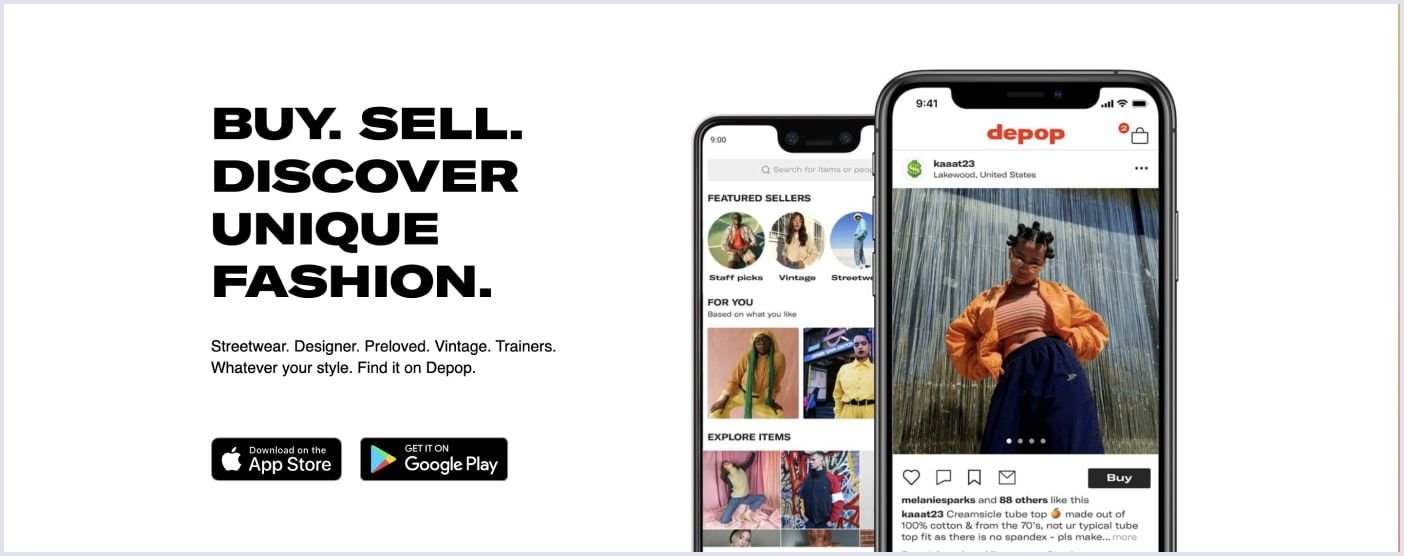
Source: Depop
Subscription fees
Offering premium memberships with exclusive benefits is another reliable monetization method known to everybody. According to it, sellers or buyers pay a regular monthly/yearly fee to access additional features on your platform.
For example, your sellers could gain access to analytics, promotional tools, or priority placement in search results. Buyers, on the other hand, might enjoy early access to new listings or discounts on certain products.
Speaking of effectiveness, this model provides recurring revenue. Simply put, all subscription fees provide a predictable income stream. Besides, premium features can improve user satisfaction and loyalty.
How Etsy implements it
Etsy offers a subscription plan called Etsy Plus, priced at $10 USD per month, tailored for sellers who want to enhance their shop’s visibility and functionality. This plan provides a suite of premium tools and benefits designed to help sellers grow their business.
Sellers of Etsy Plus have access to a variety of configurable shop options. To increase product visibility and traffic to their store, the strategy also calls for free monthly listing credits and cheap Etsy Ads.
Advertising and promotions
Using sponsored ads and promotional listings helps you to make money by leveraging the exposure of your marketplace. This approach is straightforward: sellers may pay to advertise their listings so that their products show in special featured areas or at the top of search results.
Besides, it allows you to let outside companies or brands sell their goods or services on your platform via banner advertisements or sponsored content, therefore generating extra income.
The effectiveness of this model comes from multiple revenue streams. You earn from both sellers and external advertisers. Besides, promotional tools give sellers an incentive to stay active on your platform.
How Poshmark implements it
One popular option is Closet Clear Out, a promotional event where sellers are encouraged to lower the prices of their items for a limited time. When sellers participate, Poshmark sends notifications to interested buyers, highlighting the price drop. This not only increases visibility but also creates urgency, leading to higher chances of a sale.
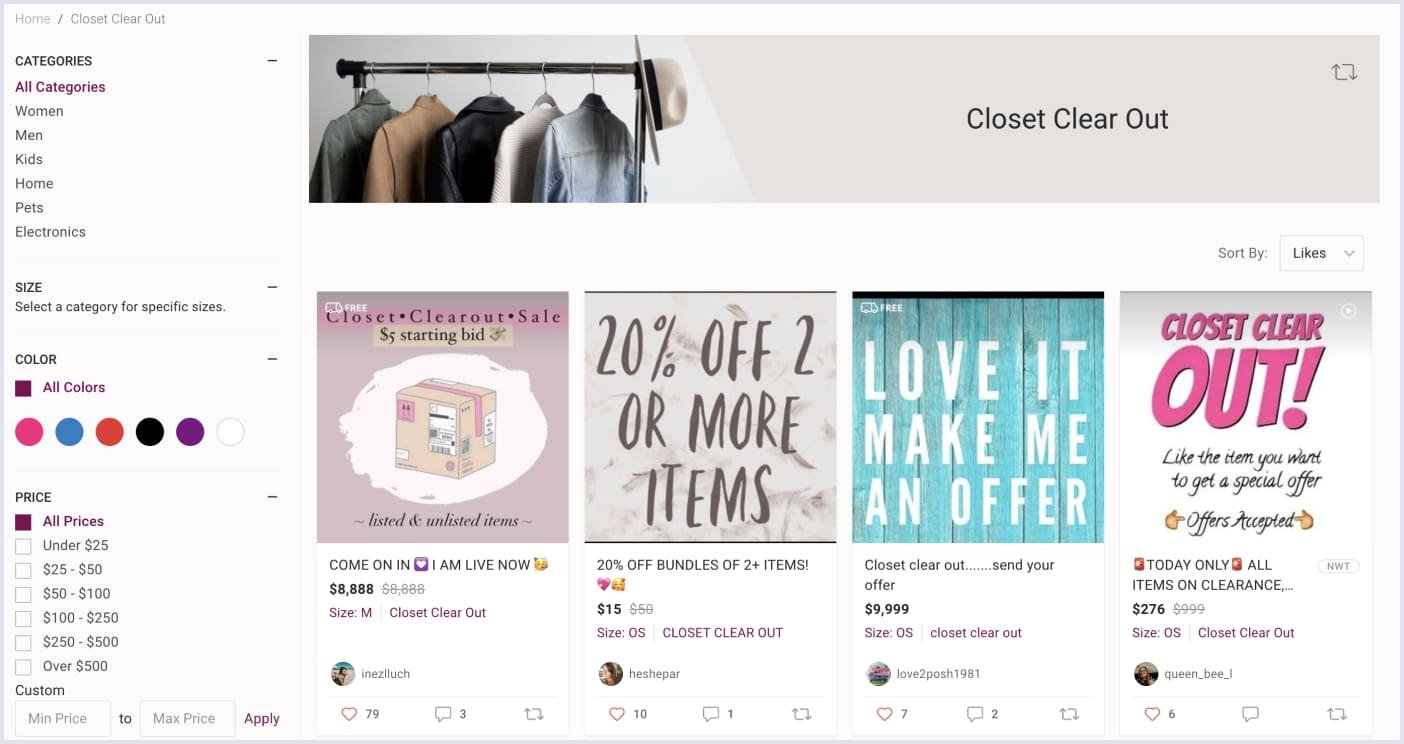
Source: Poshmark
Poshmark also offers the Promoted Closet feature, which allows sellers to pay for improved search results or placement in specialized product categories. Increased prominence of their products can help retailers draw more customers and boost sales.
The platform gains as well as sellers from these advertising and promotional tools. Poshmark makes money from promotional fees, so it's a win-win approach while sellers get more exposure and sales chances.
Bottom line
To wrap things up, you may have already noticed there are tons of aspects to take care of to launch a fashion resale marketplace. It may feel overwhelming, but it is completely doable, especially with the right approach.
Hence, feel free to get in touch with Codica. We can guide you on everything there is to know about marketplace development. Besides, our portfolio already lists successful marketplace development cases. So, let’s populate it with yours!
